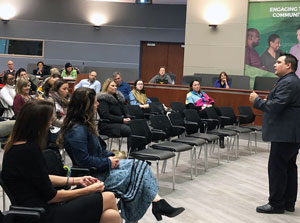
Educators learn how they can help with Indigenous reconciliation in our schools.
On November 26, Dr. Niigaawewidam James Sinclair came to the Education Centre to discuss, “What Reconciliation Looks Like” for Indigenous people and for all Canadians.
“Reconciliation is going to need every single one of us to think about it,” explains Dr. Sinclair.
He mentioned that there is still lots of work that needs to be done when it comes to reconciliation, and it starts with recognizing the wrongs of the past and not doing the status quo because it is something that has always been done.
“It might be that there are other ways to do these things. It might be ways that we can stop seeing Indigenous peoples as being inferior,” Dr. Sinclair said. “But as offering important critical ideas in the ways that they have offered important ideas in the past.”
He shared that he has even had these conversation within his own family. He had to explain to his Aunt that, “I’m your people. There is no your people.” In other words, we are all connected and we should be treated with respect and dignity.
The Power of Education
Dr. Sinclair spoke very highly of teachers and their role in helping to push reconciliation forward. He mentioned that his father, the Honourable Justice Murray Sinclair, was chair of the Truth and Reconciliation Commission (TRC) of Canada. He showed the group all the call-to-actions that TRC created and out of the 94 actions, 48 of them are education-based.
“You are teachers – I think that you are more powerful than any minister, because you have the ability to affect people’s lives,” he said. “You give gifts. You shape perceptions and ideas and are made to be altruistic. A teacher can change lives.”
At the end of the session, the crowd broke into smaller groups and discussed how they could make a difference in the reconciliation process. Dr. Sinclair inspired them to think outside the box and to be a part of the solution.
He said, “Education is what changes the conversation.”

Leave a Reply